An Online Generalized Multiscale Finite Element Method for Unsaturated Filtration Problem in Fractured Media
Abstract
1. Introduction
2. Problem Formulation
3. Fine Grid Approximation
4. Coarse Grid Approximation
- Offline stage. In the offline stage we define an offline space by constructing an offline multiscale basis function;
- Online stage. In the online stage we construct the system on the offline space and enrich offline space by online multiscale basis functions.
4.1. Offline Stage
4.2. Online Stage
5. Numerical Results
- Test 1. Computational domain with 14 fractures, , and (homogeneous porous matrix);
- Test 2. Computational domain with 14 fractures, , and (heterogeneous porous matrix);
- Test 3. Computational domain with 50 fractures, , and (heterogeneous porous matrix).
6. Conclusions
Author Contributions
Funding
Institutional Review Board Statement
Informed Consent Statement
Data Availability Statement
Conflicts of Interest
References
- Celia, M.A.; Bouloutas, E.T.; Zarba, R.L. A general mass-conservative numerical solution for the unsaturated flow equation. Water Resour. Res. 1990, 26, 1483–1496. [Google Scholar] [CrossRef]
- Celia, M.A.; Binning, P. A mass conservative numerical solution for two-phase flow in porous media with application to unsaturated flow. Water Resour. Res. 1992, 28, 2819–2828. [Google Scholar] [CrossRef]
- Haverkamp, R.; Vauclin, M.; Touma, J.; Wierenga, P.; Vachaud, G. A Comparison of Numerical Simulation Models For One-Dimensional Infiltration. Soil Sci. Soc. Am. J. 1977, 41, 285–294. [Google Scholar] [CrossRef]
- Eymard, R.; Gutnic, M.; Hilhorst, D. The finite volume method for Richards equation. Comput. Geosci. 1999, 3, 259–294. [Google Scholar] [CrossRef]
- Pachepsky, Y.; Timlin, D.; Rawls, W. Generalized Richards’ equation to simulate water transport in unsaturated soils. J. Hydrol. 2003, 272, 3–13. [Google Scholar] [CrossRef]
- Zienkiewicz, O.C.; Taylor, R.L.; Nithiarasu, P.; Zhu, J. The Finite Element Method; McGraw-Hill: London, UK, 1977; Volume 3. [Google Scholar]
- Zienkiewicz, O.C.; Taylor, R.L.; Zhu, J.Z. The Finite Element Method: Its Basis and Fundamentals; Elsevier: Amsterdam, The Netherlands, 2005. [Google Scholar]
- Bathe, K.J. Finite element method. In Wiley Encyclopedia of Computer Science and Engineering; Massachusetts Institute of Technology: Cambridge, MA, USA, 2007; pp. 1–12. [Google Scholar]
- Efendiev, Y.; Hou, T.Y. Multiscale Finite Element Methods: Theory and Applications; Springer: Berlin, Germany, 2009; Volume 4. [Google Scholar]
- Hou, T.Y.; Wu, X.H. A multiscale finite element method for elliptic problems in composite materials and porous media. J. Comput. Phys. 1997, 134, 169–189. [Google Scholar] [CrossRef]
- Efendiev, Y.; Hou, T.Y.; Ginting, V. Multiscale finite element methods for nonlinear problems and their applications. Commun. Math. Sci. 2004, 2, 553–589. [Google Scholar] [CrossRef]
- Hajibeygi, H.; Bonfigli, G.; Hesse, M.A.; Jenny, P. Iterative multiscale finite-volume method. J. Comput. Phys. 2008, 227, 8604–8621. [Google Scholar] [CrossRef]
- Lunati, I.; Jenny, P. Multiscale finite-volume method for compressible multiphase flow in porous media. J. Comput. Phys. 2006, 216, 616–636. [Google Scholar] [CrossRef]
- Lunati, I.; Jenny, P. Multiscale finite-volume method for density-driven flow in porous media. Comput. Geosci. 2008, 12, 337–350. [Google Scholar] [CrossRef][Green Version]
- Abdulle, A.; Weinan, E.; Engquist, B.; Vanden-Eijnden, E. The heterogeneous multiscale method. Acta Numer. 2012, 21, 1–87. [Google Scholar] [CrossRef]
- Weinan, E.; Engquist, B.; Li, X.; Ren, W.; Vanden-Eijnden, E. Heterogeneous multiscale methods: A review. Commun. Comput. Phys. 2007, 2, 367–450. [Google Scholar]
- Chung, E.; Efendiev, Y.; Hou, T.Y. Adaptive multiscale model reduction with generalized multiscale finite element methods. J. Comput. Phys. 2016, 320, 69–95. [Google Scholar] [CrossRef]
- Chung, E.T.; Efendiev, Y.; Fu, S. Generalized multiscale finite element method for elasticity equations. GEM Int. J. Geomath. 2014, 5, 225–254. [Google Scholar] [CrossRef]
- Efendiev, Y.; Galvis, J.; Hou, T.Y. Generalized multiscale finite element methods (GMsFEM). J. Comput. Phys. 2013, 251, 116–135. [Google Scholar] [CrossRef]
- Chung, E.T.; Efendiev, Y.; Leung, W.T. Constraint energy minimizing generalized multiscale finite element method. Comput. Methods Appl. Mech. Eng. 2018, 339, 298–319. [Google Scholar] [CrossRef]
- Cheung, S.W.; Chung, E.T.; Efendiev, Y.; Leung, W.T.; Vasilyeva, M. Constraint energy minimizing generalized multiscale finite element method for dual continuum model. arXiv 2018, arXiv:1807.10955. [Google Scholar]
- Fu, S.; Chung, E.; Mai, T. Constraint energy minimizing generalized multiscale finite element method for nonlinear poroelasticity and elasticity. J. Comput. Phys. 2020, 417, 109569. [Google Scholar] [CrossRef]
- Chen, Z.; Hou, T. A mixed multiscale finite element method for elliptic problems with oscillating coefficients. Math. Comput. 2003, 72, 541–576. [Google Scholar] [CrossRef]
- Chung, E.T.; Efendiev, Y.; Lee, C.S. Mixed generalized multiscale finite element methods and applications. Multiscale Model. Simul. 2015, 13, 338–366. [Google Scholar] [CrossRef]
- Aarnes, J.E.; Efendiev, Y.; Jiang, L. Mixed multiscale finite element methods using limited global information. Multiscale Model. Simul. 2008, 7, 655–676. [Google Scholar] [CrossRef]
- He, X.; Ren, L. An adaptive multiscale finite element method for unsaturated flow problems in heterogeneous porous media. J. Hydrol. 2009, 374, 56–70. [Google Scholar] [CrossRef]
- Ginting, V.E. Computational Upscaled Modeling of Heterogeneous Porous Media Flow Utilizing Finite Volume Method; Texas A&M University: College Station, TX, USA, 2005. [Google Scholar]
- Spiridonov, D.; Vasilyeva, M.; Chung, E.T.; Efendiev, Y.; Jana, R. Multiscale Model Reduction of the Unsaturated Flow Problem in Heterogeneous Porous Media with Rough Surface Topography. Mathematics 2020, 8, 904. [Google Scholar] [CrossRef]
- Chen, Z.; Deng, W.; Ye, H. Upscaling of a class of nonlinear parabolic equations for the flow transport in heterogeneous porous media. Commun. Math. Sci. 2005, 3, 493–515. [Google Scholar] [CrossRef]
- Akkutlu, I.; Efendiev, Y.; Vasilyeva, M. Multiscale model reduction for shale gas transport in fractured media. Comput. Geosci. 2016, 20, 953–973. [Google Scholar] [CrossRef]
- Ţene, M.; Al Kobaisi, M.S.; Hajibeygi, H. Algebraic multiscale method for flow in heterogeneous porous media with embedded discrete fractures (F-AMS). J. Comput. Phys. 2016, 321, 819–845. [Google Scholar] [CrossRef]
- Bosma, S.; Hajibeygi, H.; Tene, M.; Tchelepi, H.A. Multiscale finite volume method for discrete fracture modeling on unstructured grids (MS-DFM). J. Comput. Phys. 2017, 351, 145–164. [Google Scholar] [CrossRef]
- Ţene, M.; Bosma, S.B.; Al Kobaisi, M.S.; Hajibeygi, H. Projection-based Embedded Discrete Fracture Model (pEDFM). Adv. Water Resour. 2017, 105, 205–216. [Google Scholar] [CrossRef]
- Hajibeygi, H.; Kavounis, D.; Jenny, P. A hierarchical fracture model for the iterative multiscale finite volume method. J. Comput. Phys. 2011, 230, 8729–8743. [Google Scholar] [CrossRef]
- Chung, E.T.; Efendiev, Y.; Leung, T.; Vasilyeva, M. Coupling of multiscale and multi-continuum approaches. GEM Int. J. Geomath. 2017, 8, 9–41. [Google Scholar] [CrossRef]
- Akkutlu, I.Y.; Efendiev, Y.; Vasilyeva, M.; Wang, Y. Multiscale model reduction for shale gas transport in poroelastic fractured media. J. Comput. Phys. 2018, 353, 356–376. [Google Scholar] [CrossRef]
- Chung, E.T.; Efendiev, Y.; Leung, W.T.; Vasilyeva, M.; Wang, Y. Non-local multi-continua upscaling for flows in heterogeneous fractured media. J. Comput. Phys. 2018, 372, 22–34. [Google Scholar] [CrossRef]
- Vasilyeva, M.; Chung, E.T.; Cheung, S.W.; Wang, Y.; Prokopev, G. Nonlocal multicontinua upscaling for multicontinua flow problems in fractured porous media. J. Comput. Appl. Math. 2019, 355, 258–267. [Google Scholar] [CrossRef]
- Vasilyeva, M.; Chung, E.T.; Efendiev, Y.; Kim, J. Constrained energy minimization based upscaling for coupled flow and mechanics. J. Comput. Phys. 2019, 376, 660–674. [Google Scholar] [CrossRef]
- Spiridonov, D.; Vasilyeva, M.; Chung, E.T. Generalized Multiscale Finite Element method for multicontinua unsaturated flow problems in fractured porous media. J. Comput. Appl. Math. 2020, 370, 112594. [Google Scholar] [CrossRef]
- Chung, E.T.; Efendiev, Y.; Leung, W.T. Residual-driven online generalized multiscale finite element methods. J. Comput. Phys. 2015, 302, 176–190. [Google Scholar] [CrossRef]
- Tyrylgin, A.; Chen, Y.; Vasilyeva, M.; Chung, E.T. Multiscale model reduction for the Allen-Cahn problem in perforated domains. J. Comput. Appl. Math. 2021, 381, 113010. [Google Scholar] [CrossRef]
- Efendiev, Y.; Lee, S.; Li, G.; Yao, J.; Zhang, N. Hierarchical multiscale modeling for flows in fractured media using generalized multiscale finite element method. GEM Int. J. Geomath. 2015, 6, 141–162. [Google Scholar] [CrossRef]
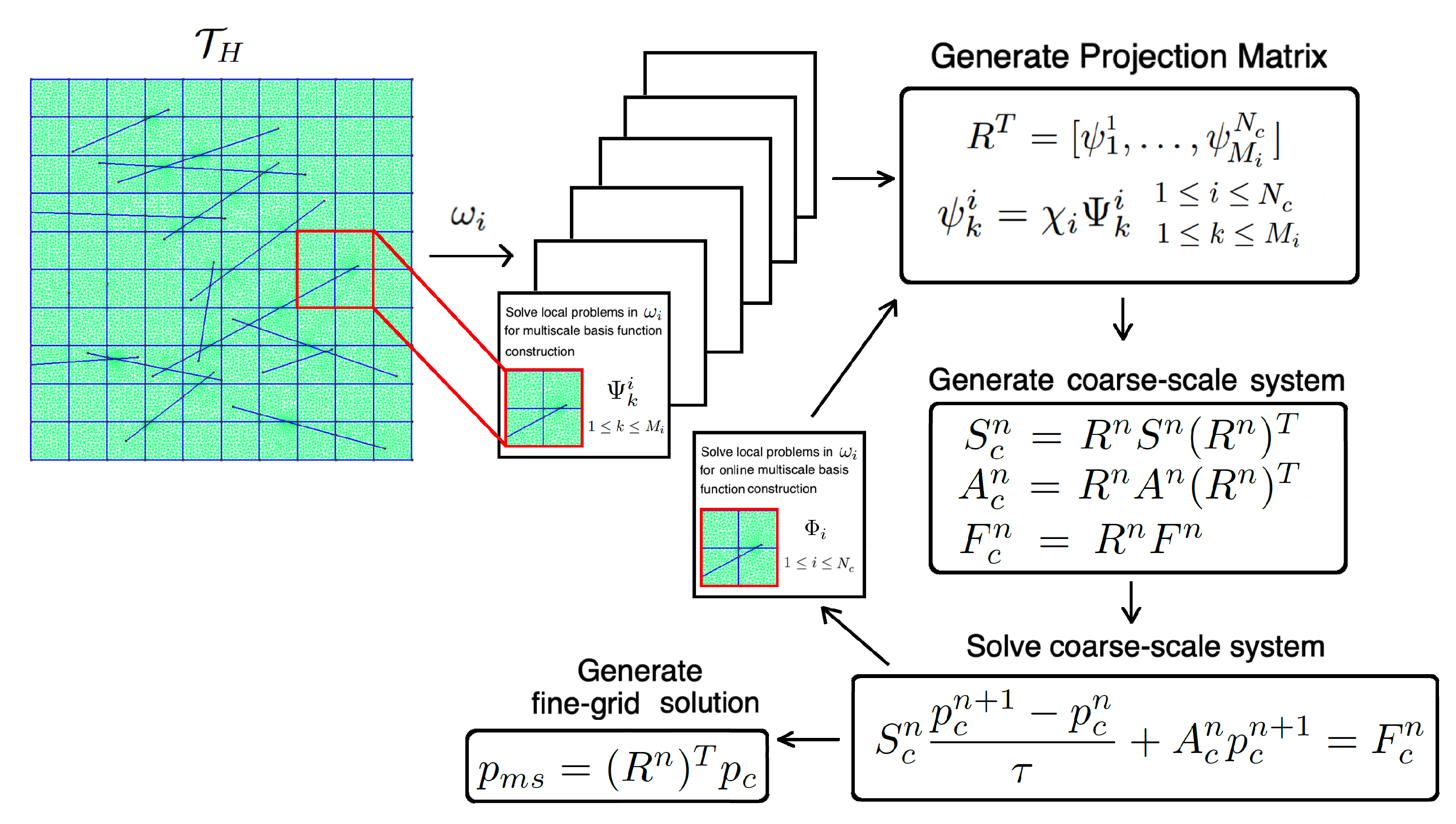

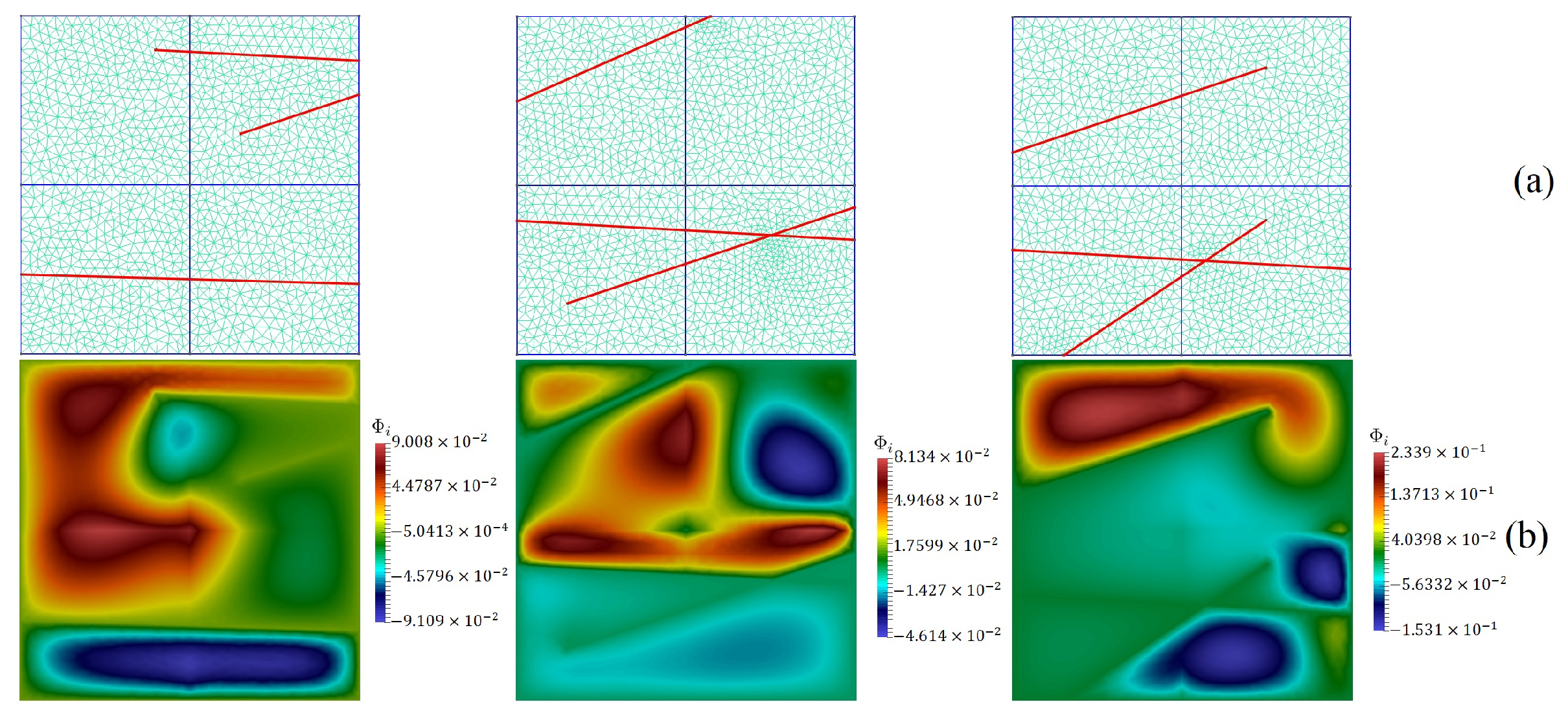
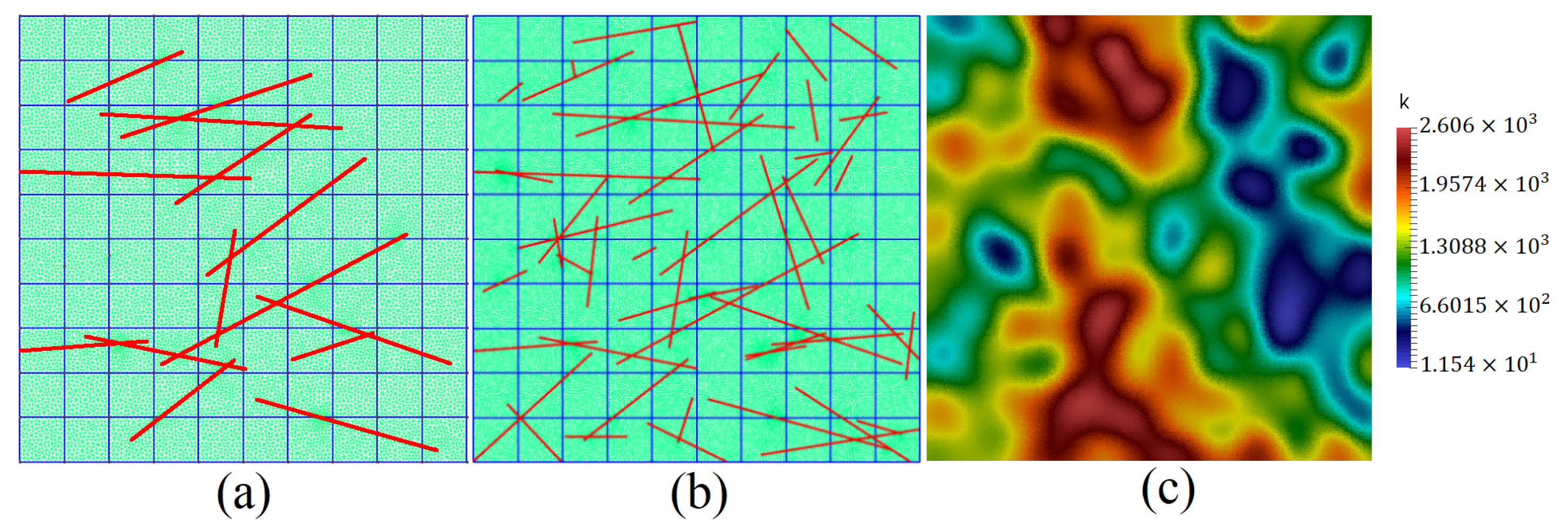

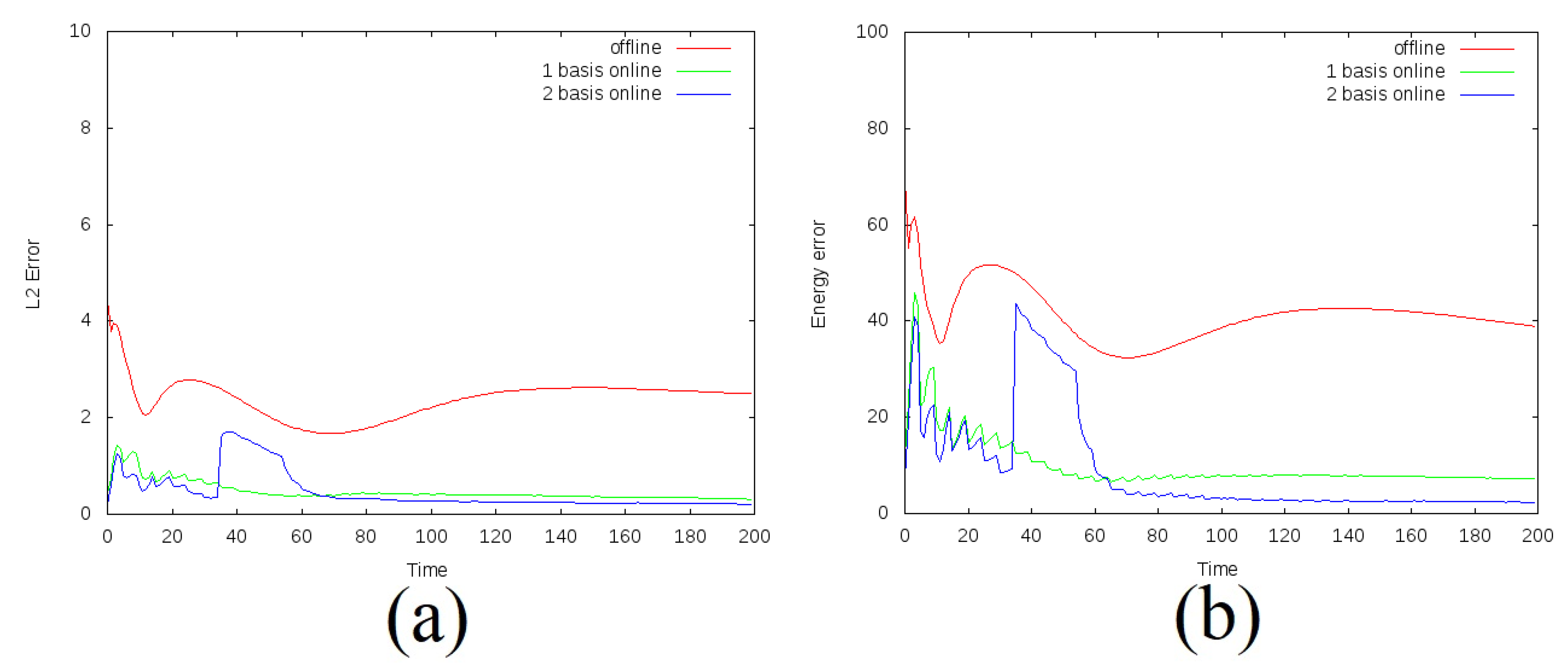
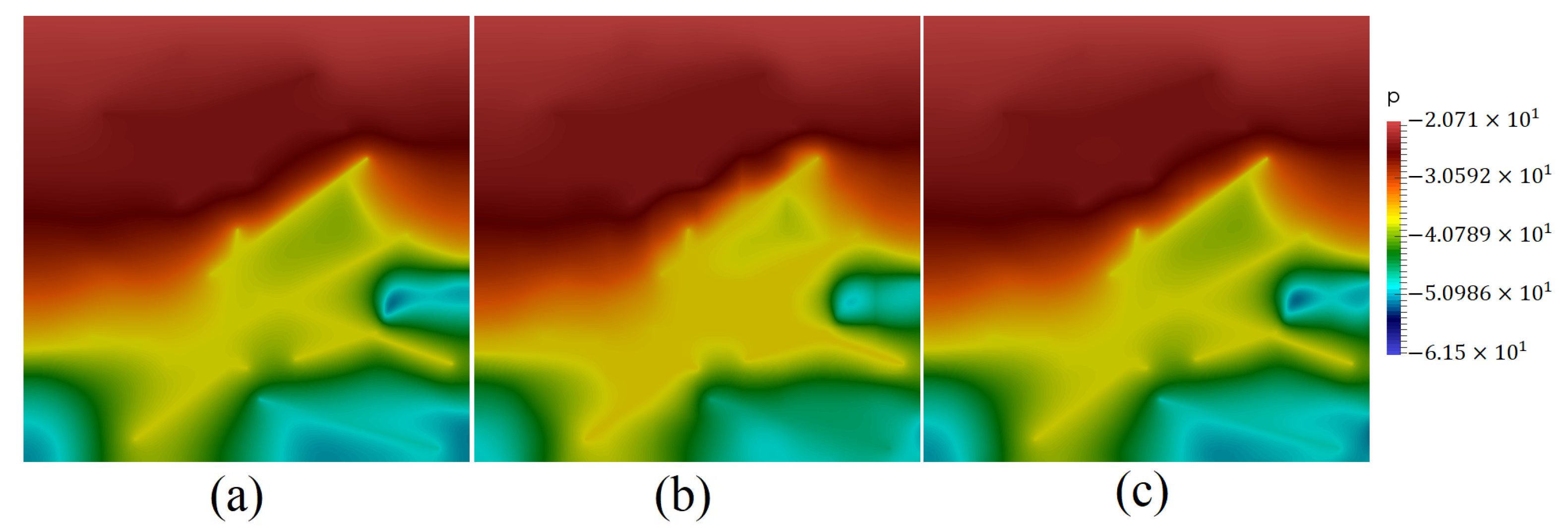
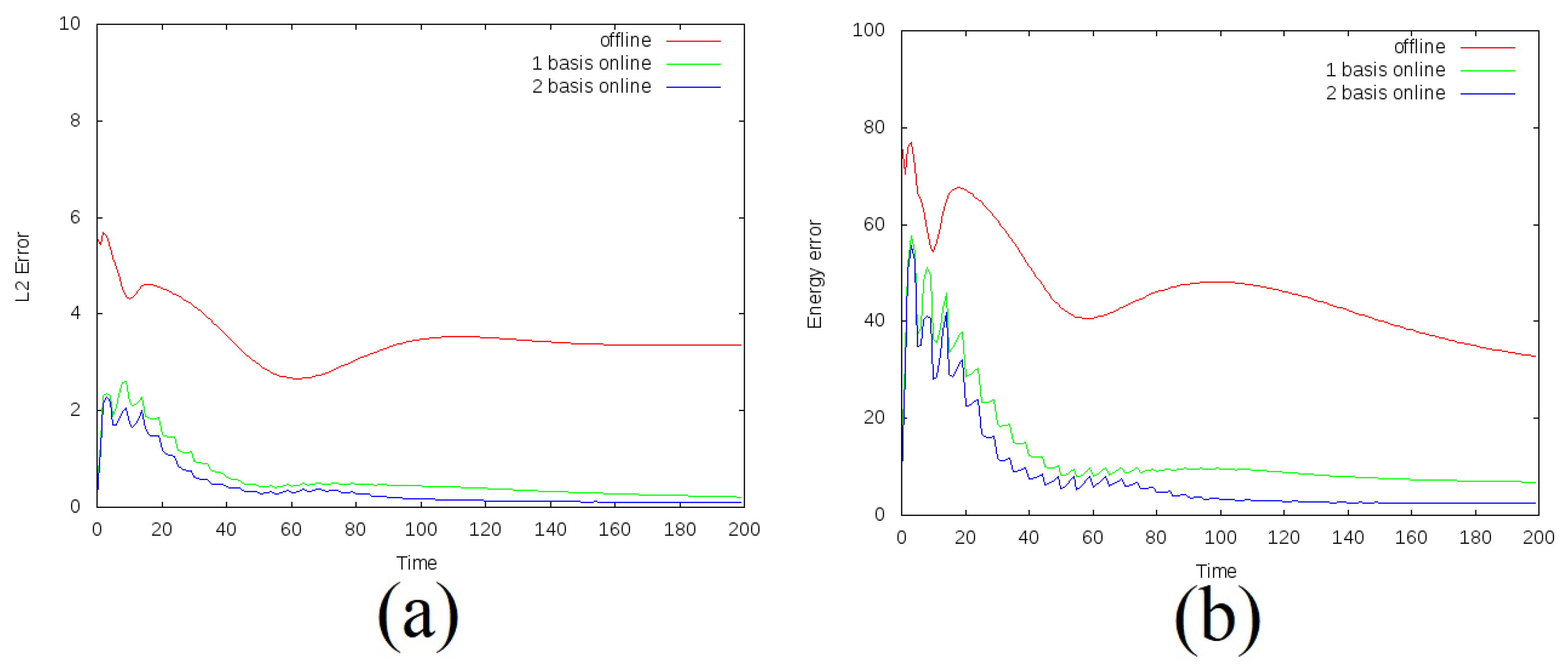
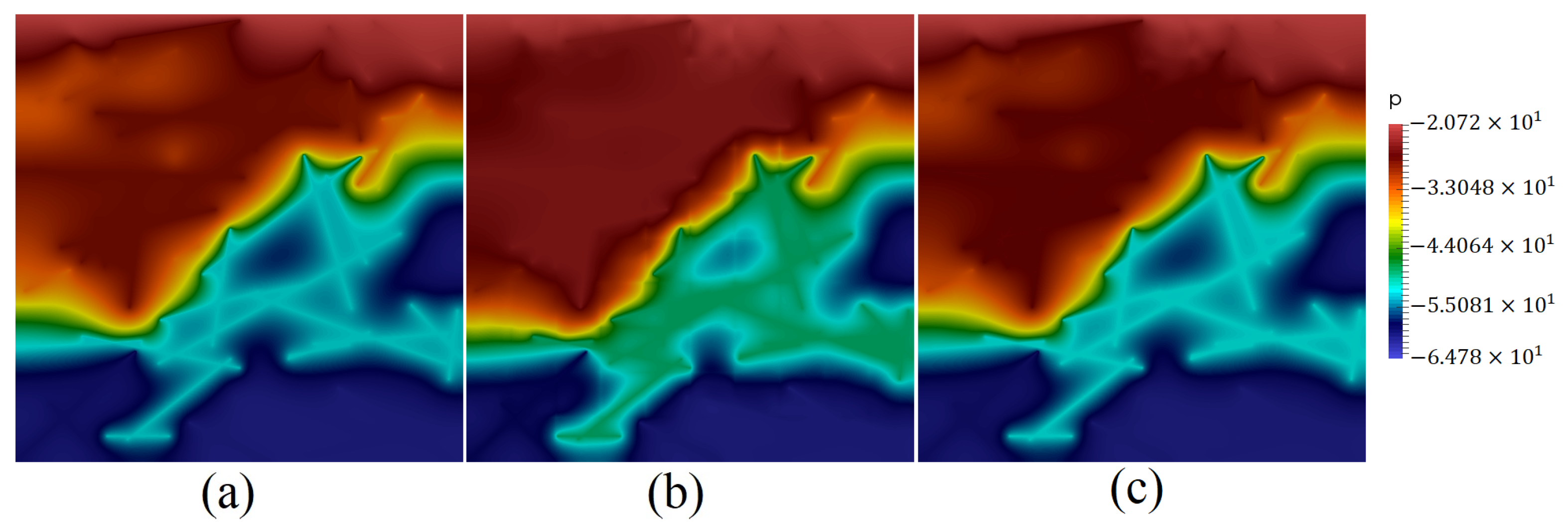
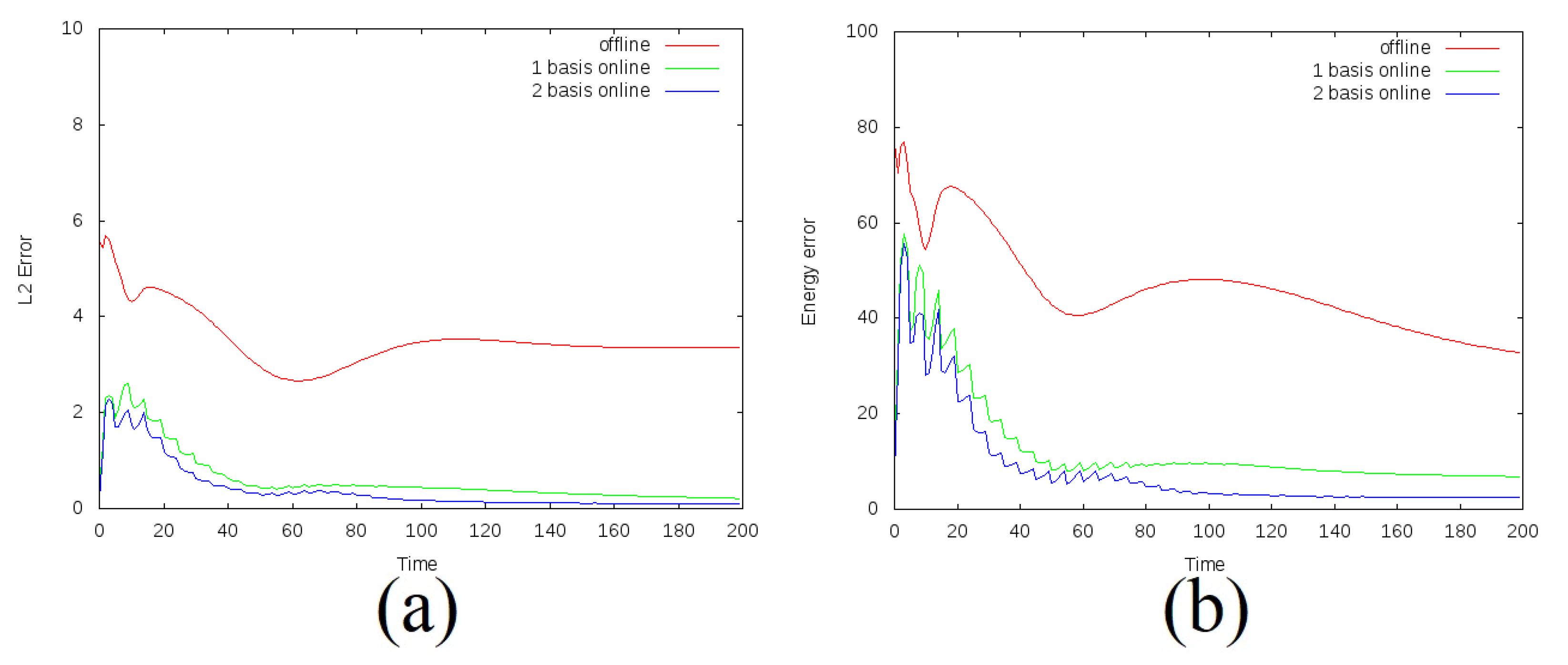
| M | Offline Basis | 1 Online Basis | 2 Online Basis | ||||||
|---|---|---|---|---|---|---|---|---|---|
| 2 | 242 | 97.393 | 155.472 | 363 | 97.049 | 152.071 | 484 | 96.716 | 151.544 |
| 3 | 363 | 2.502 | 38.883 | 484 | 0.307 | 7.203 | 605 | 0.201 | 2.341 |
| 4 | 484 | 1.746 | 32.202 | 605 | 0.423 | 6.547 | 726 | 0.283 | 2.099 |
| 6 | 726 | 0.453 | 19.705 | 847 | 0.334 | 2.009 | 968 | 0.342 | 1.554 |
| 8 | 968 | 0.289 | 15.176 | 1089 | 0.351 | 1.512 | 1210 | 0.347 | 1.218 |
| M | Offline Basis | 1 Online Basis | 2 Online Basis | ||||||
|---|---|---|---|---|---|---|---|---|---|
| 2 | 242 | 34.272 | 95.948 | 363 | 24.261 | 89.973 | 484 | 23.513 | 88.621 |
| 3 | 363 | 2.908 | 33.599 | 484 | 0.326 | 8.874 | 605 | 0.128 | 3.758 |
| 4 | 484 | 2.091 | 28.741 | 605 | 0.264 | 6.335 | 726 | 0.107 | 2.646 |
| 6 | 726 | 0.665 | 16.121 | 847 | 0.092 | 2.333 | 968 | 0.055 | 1.451 |
| 8 | 968 | 0.422 | 12.309 | 1089 | 0.048 | 1.339 | 1210 | 0.064 | 0.591 |
| M | Offline Basis | 1 Online Basis | 2 Online Basis | ||||||
|---|---|---|---|---|---|---|---|---|---|
| 2 | 242 | 58.043 | 100.00 | 363 | 57.908 | 99.937 | 484 | 57.854 | 99.862 |
| 4 | 484 | 33.674 | 90.899 | 605 | 20.851 | 85.816 | 726 | 20.901 | 77.872 |
| 6 | 726 | 25.274 | 72.768 | 847 | 15.923 | 49.371 | 968 | 16.146 | 59.431 |
| 8 | 968 | 17.415 | 58.506 | 1089 | 10.107 | 38.239 | 1210 | 8.447 | 32.415 |
| 12 | 1452 | 6.775 | 33.893 | 1573 | 1.715 | 8.929 | 1693 | 1.134 | 5.565 |
| 16 | 1936 | 0.653 | 22.980 | 2057 | 0.062 | 2.282 | 2178 | 0.038 | 0.793 |
| 20 | 2420 | 0.566 | 21.614 | 2541 | 0.041 | 1.981 | 2662 | 0.017 | 0.645 |
Publisher’s Note: MDPI stays neutral with regard to jurisdictional claims in published maps and institutional affiliations. |
© 2021 by the authors. Licensee MDPI, Basel, Switzerland. This article is an open access article distributed under the terms and conditions of the Creative Commons Attribution (CC BY) license (https://creativecommons.org/licenses/by/4.0/).
Share and Cite
Spiridonov, D.; Vasilyeva, M.; Tyrylgin, A.; Chung, E.T. An Online Generalized Multiscale Finite Element Method for Unsaturated Filtration Problem in Fractured Media. Mathematics 2021, 9, 1382. https://doi.org/10.3390/math9121382
Spiridonov D, Vasilyeva M, Tyrylgin A, Chung ET. An Online Generalized Multiscale Finite Element Method for Unsaturated Filtration Problem in Fractured Media. Mathematics. 2021; 9(12):1382. https://doi.org/10.3390/math9121382
Chicago/Turabian StyleSpiridonov, Denis, Maria Vasilyeva, Aleksei Tyrylgin, and Eric T. Chung. 2021. "An Online Generalized Multiscale Finite Element Method for Unsaturated Filtration Problem in Fractured Media" Mathematics 9, no. 12: 1382. https://doi.org/10.3390/math9121382
APA StyleSpiridonov, D., Vasilyeva, M., Tyrylgin, A., & Chung, E. T. (2021). An Online Generalized Multiscale Finite Element Method for Unsaturated Filtration Problem in Fractured Media. Mathematics, 9(12), 1382. https://doi.org/10.3390/math9121382







